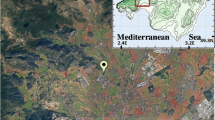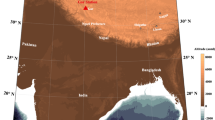Abstract
In order to study the factors influencing the formation of the vertical component of atmospheric electric field (AEF) strength E z , the data on meteorological parameters (atmospheric pressure, air temperature, and snow depth) are applied, as well as the data of radon Rn emanation into the atmosphere. Determined is the seasonal dependence on the radon emanation to the atmospheric surface layer due to the decrease in the upper soil layer permeability in wintertime that results in the decrease in the surface layer ionization which explains the difference between the maximum and minimum values of electric field strength within the annual variations amounting to ∼100 V/m for the observational period. It is demonstrated that during the negative mean diurnal temperatures (November-April), the cyclone arrival from southern directions is accompanied by significant decrease in AEF E z due to the increase in the radon flow under the influence of considerable fall of atmospheric pressure and dramatic warming by 10–15°C resulting in the increase in upper soil layer permeability.
Similar content being viewed by others
References
R. A. Allik and N. I. Leushin, “Some Conclusions from the Observations of Atmospheric Electric Conditions in Slutsk (Pavlovsk) for 20 Years (1916–1935),” Trudy GGO (Trans. Main Geophys. Observatory), Issue 30: Atmospheric Electricity, No. 2 (1939) [in Russian].
J. Box and G. M. Jenkins, Time Series Analysis: Forecasting and Control. 1st Edition (Mir, Moscow, 1974) [Transl. from Engl.].
G. I. Druzhin and N. V. Cherneva, “Detection of Lightning Sources Associated with the Cyclones in Kamchatka,” in Trans. 21st All-Russian Scientific Conference “Propagation of Radio Waves,” Yoshkar-Ola, May 25–27, 2005, Vol. 1 (MarGTU, Yoshkar-Ola, 2005) [in Russian].
V. I. Kondratyuk, Climate of Kamchatka (Gidrometeoizdat, Leningrad, 1983) [in Russian].
V. V. Kuznetsov, N. V. Cherneva, and G. I. Druzhin, “Influence of Cyclones on the Atmospheric Electric Field of Kamchatka,” Dokl. Akad. Nauk, No. 4, 412 (2007) [Dokl. Earth Sci., No. 4, 412 (2007)].
A. A. Lyubushin, Jr. and V. A. Malugin, “Statistical Analysis of the Groundwater Level Response to the Air Pressure Variations,” Fiz. Zemli, No. 12 (1993) [Izv., Phys. Solid Earth, No. 12 (1993)].
L. G. Makhotkin, “Annual Variations of Potential Gradient and Global Changes in Snow Cover Area,” Trudy GGO (Trans. Main Geophys. Observatory), Atmospheric Electricity, No. 401 (1980) [in Russian].
P. P. Firstov, E. A. Ponomarev, N. V. Cherneva, et al., “On the Effects of Air Pressure Variations on Radon Exhalation into the Atmosphere,” Vulkanol. Seismol., No. 6 (2007) [J. Volcanol. Seismol., No. 6 (2007)].
P. P. Firstov, N. V. Cherneva, E. A. Ponomarev, and A. V. Buzevich, “Subsoil Radon and Electric Field Intensity in the Atmosphere in Case of Petropavlovsk-Kamchatsky Geodynamic Chain in 1998–2003,” Vestnik KRAUNTs, Ser. Nauki o Zemle, No. 1 (2006) [Bull. Kamchatka Regional Association “Educational Scientific Center,” Earth Sci., No. 1 (2006)].
N. V. Cherneva and G. I. Druzhin, “On the Possibility to Register of Cyclones in Kamchatka Using the Electromagnetic VLF Radiation,” in Proceedings of the 3rd International Conference “Solar-Terrestrial Relationship and Earthquake Predecessors” (IKIR DVO RAN, 2004) [in Russian].
N. V. Cherneva, E. A. Ponomarev, P. P. Firstov, and A. V. Buzevich, “Basic Models of Sources of Atmospheric Electric Field Vertical Component Variations,” Vestnik KRAUNTs, Ser. Nauki o Zemle, No. 2 (2007) [Bull. Kamchatka Regional Association “Educational Scientific Center,” Earth Sci., No. 2 (2007)].
N. V. Cherneva. P. P. Firstov, and E. A. Ponomarev, “Temporal Variations of Atmospheric Electricity in Paratunka Observatory, Kamchatka,” in Trans. 6th Russian Conference on Atmospheric Electricity (Nizhny Novgorod, 2007) [in Russian].
R. G. Harrison, “Long-term Measurements of the Global Atmospheric Electric Circuit at Eskdalemuir, Scotland, 1911–1981,” Atmos. Res., 70 (2004).
R. G. Harrison, “Twentieth Century Secular Decrease in the Atmospheric Potential Gradient,” Geophys. Res. Lett., No. 14, 29 (2002).
F. Marcz and R. G. Harrison, “Long-term Changes in Atmospheric Electrical Parameters Observed at Nagycenk (Hungary) and the UK Observatories at Eskdalemuir and Kew,” Ann. Geophys., 21 (2003).
Author information
Authors and Affiliations
Additional information
Original Russian Text © N.V. Cherneva, P.P. Firstov, 2013, published in Meteorologiya i Gidrologiya, 2013, No. 3, pp. 56–65.
About this article
Cite this article
Cherneva, N.V., Firstov, P.P. Weather factor effects on electric parameters in the lower atmosphere. Russ. Meteorol. Hydrol. 38, 177–184 (2013). https://doi.org/10.3103/S1068373913030060
Received:
Published:
Issue Date:
DOI: https://doi.org/10.3103/S1068373913030060




